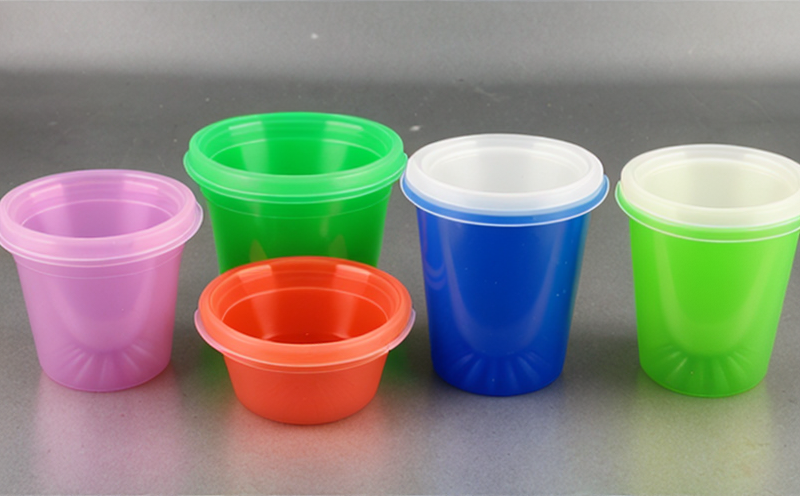DIN 53372 Disposable Plastics Stress Cracking Resistance Testing
The DIN 53372 test is a critical procedure used to evaluate the stress cracking resistance of disposable plastics. This test is particularly important in sectors where materials are subjected to cyclic loading, such as in medical devices and packaging industries.
Stress cracking occurs when a material experiences prolonged exposure to loads that exceed its elastic limit, leading to microscopic cracks which propagate under further load application. These cracks can significantly reduce the service life of disposable plastics and ultimately affect product reliability and safety.
The DIN 53372 method simulates real-world conditions by subjecting samples to a combination of stress and heat, which are the primary factors contributing to stress cracking in many applications. This test is not only essential for ensuring compliance with regulatory standards but also plays a pivotal role in enhancing product quality.
The testing procedure involves several steps: specimen preparation, conditioning, loading, and observation under specified conditions. Specimens are typically cut from the raw material or finished products to ensure they represent the intended use. After conditioning at elevated temperatures for an extended period, the samples undergo a load application cycle designed to induce stress cracking.
The DIN 53372 test is compliant with international standards such as ISO and ASTM, ensuring that the results are credible and widely accepted in global markets. Compliance with these standards not only assures customers of product quality but also facilitates easier market access through regulatory approval processes.
Understanding the specific requirements for this test is crucial for those involved in research and development (R&D) or purchasing decisions within organizations. By knowing how to prepare specimens correctly and interpreting results accurately, stakeholders can make informed choices that contribute to better product design and manufacturing practices.
The importance of stress cracking resistance testing cannot be overstated, especially given the increasing demand for sustainable materials in disposable plastic products. Ensuring robustness against environmental stresses helps manufacturers meet sustainability goals while maintaining high standards of quality.
Scope and Methodology
The DIN 53372 test focuses on evaluating the resistance to stress cracking in disposable plastics under specified conditions. The scope includes both raw materials and finished products, covering a wide range of applications where cyclic loading is common.
The methodology involves several key steps: specimen preparation, conditioning, load application, and visual inspection. Specimens are prepared by cutting specific dimensions based on the test requirements. These specimens are then conditioned at elevated temperatures to simulate real-world storage conditions before undergoing stress testing.
Load application is performed using a controlled environment where temperature and humidity levels can be precisely regulated. This ensures that all samples experience identical environmental factors, minimizing variability in results. After the load cycle, the samples are visually inspected for any signs of cracking or damage.
The acceptance criteria for this test vary depending on the specific application and material type. Generally, specimens must remain intact without visible cracks after undergoing the prescribed stress conditions to pass the test. Compliance with these criteria indicates that the tested materials exhibit adequate stress cracking resistance suitable for their intended use.
Why Choose This Test
Choosing DIN 53372 testing offers several advantages over other methods, making it an indispensable tool in assessing disposable plastic quality. One of the primary benefits is its ability to simulate actual usage conditions accurately, providing reliable data on material performance.
This test helps identify potential issues early in the development process, allowing for improvements before products reach consumers. Additionally, compliance with DIN 53372 ensures that manufacturers adhere to strict quality standards set by international bodies like ISO and ASTM, enhancing brand reputation and customer trust.
The results from this test are widely recognized across various industries, simplifying regulatory compliance processes. For quality managers and procurement officers, choosing this test means leveraging robust data points for decision-making purposes. It also provides valuable insights into material behavior under stress conditions, aiding in optimizing design parameters for enhanced performance.
Moreover, the DIN 53372 test supports sustainability initiatives by ensuring that disposable plastics meet stringent durability requirements without compromising environmental impact. By selecting this method, organizations contribute positively towards reducing waste and promoting eco-friendly practices.
Competitive Advantage and Market Impact
Earning a reputation for producing high-quality disposable plastics that meet rigorous testing standards like DIN 53372 can significantly enhance a company's competitive edge. This certification not only sets your products apart from competitors but also builds strong brand loyalty among consumers.
Compliance with such stringent tests demonstrates commitment to excellence, which is increasingly valued by customers who prioritize both product quality and environmental responsibility. By meeting these standards, businesses can anticipate increased sales volumes as satisfied customers recommend their offerings to others.
In terms of market impact, adhering to DIN 53372 ensures that your products are well-positioned for global markets where stringent regulatory requirements apply. This compliance opens doors to international partnerships and collaborations, fostering growth opportunities domestically and internationally.
Furthermore, staying ahead in innovation through continuous improvement based on rigorous testing can lead to new product developments that better meet evolving customer needs. Leveraging DIN 53372 testing provides a solid foundation for ongoing advancements in material science and engineering.





